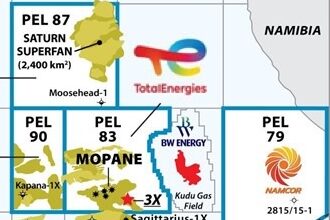Global oil slump puts Africa’s drilling potential on hold
Core projects appear to be going ahead, but exploration takes big hit, forcing significant dayrate cuts, rig stacking
By Alex Endress, Editorial Coordinator
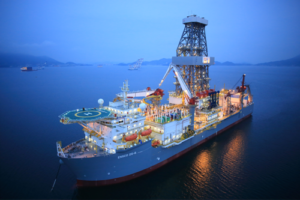
Although significant potential remains for increased drilling activity in Africa, the global oil price slump has left this market stagnant for now. Exploration activity throughout the continent was largely on hiatus in 2015, and if oil prices remain low through 2016, this trend is almost certain to continue.
The drop in exploration activity is a result of reactionary budget cuts, as operator profit margins have become increasingly strained due to the still-falling oil prices. Such was the case for Total, an operator that spends a third of its total investments on the African continent. “The impact of the low-priced oil environment currently is that we have started the project of strong cuts and reduction of costs,” Benoît Ludot, Vice President Drilling & Completion for Total Exploration-Production, said.
Industrywide, African upstream capital expenditures were reduced by as much as 50% in 2015 from 2014 levels, according to PricewaterhouseCoopers (PwC). These significant cuts have made it very difficult for rigs to find work. Those that do win contracts must operate at sharply reduced dayrates – down by 40% from 2014 rates, in some cases.
From January 2014 to September 2015, the number of active offshore drilling rigs dropped from 31 to 23. Onshore, the active rig count fell from 77 to 46. Major personnel cuts have also taken place, with approximately 87,000 people – equivalent to 9% of the total workforce in Africa’s upstream oil and gas sector – losing their jobs.
Time to readjust government policies
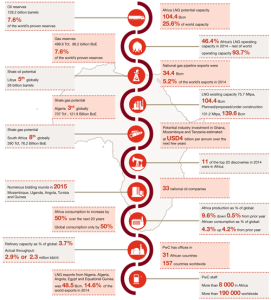
In the initial days of this downturn, the industry was hopeful that there would be a quick uptake in oil prices. Now, however, the attitude has become “lower for longer,” PwC Partner/Director Chris Bredenhann said.
In a PwC survey conducted in spring 2015, 90% of respondents said they expected a Brent price range of $60-$90/bbl in 2016. “There was an expectation that the lower prices would push more unconventional players out of the market due to a perceived break-even point of around $50/bbl,” Mr Bredenhann said. “However, cost savings and technological advances meant that this break-even point was overtaken by technological and other developments. As the market realized this, companies adjusted their expectations.”
Governments are also realizing that an exclusive reliance on oil revenues in their economies is not sustainable. PwC suggested that now is a good time for African governments to reassess and readjust tax regimes to align with lower oil prices. Respondents in the spring 2015 PwC survey ranked the continent’s uncertain regulatory environment as the top challenge to doing business. “There seems to be a disconnect between government policy in the way that the governments proceed and what the reality is in the market,” he described.
During the boom, “governments were quick to try and maximize returns or get better rates out of the industry, but the tides have turned,” he said. “Governments would do well to have a look at the regulatory environments and fiscal regimes to make sure they are as attractive as possible because, in a downturn, you’re not going to get the free flow investment that you would have expected.”
Dr Duncan Clarke, Founder and Chairman of the upstream advisory firm Global Pacific & Partners, agrees that governmental entities in Africa have an important role to play. By implementing more attractive policies for foreign investments, they can, as stakeholders, encourage investment in oil and gas. In this manner, he believes, governments will do more to help local oil and gas economies remain globally competitive, independent of the oil price cycles.
The top initiative that could impact competitiveness, Dr Clarke said, is to separate Africa’s national oil companies from the conflicting fiduciary obligations of the governments. “If they could be pushed to be more commercial, if they could be separated from the ministries and the licensing agencies, and if the playing field was leveled, all those things would be the kinds of reforms that would put the African countries into a more competitive landscape” since Africa tends to push state interests above and beyond private interest,” he said.
Some countries do better at this than others, he acknowledged. “It’s a matter of design or default. The ones that design the adjustments and adaptation will do better. Those that must do it through default and crisis will obviously suffer.”
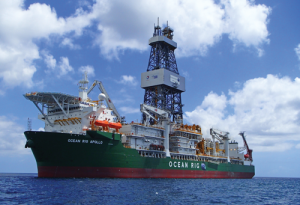
In fact, the ability of African governments to attract business in the midst of the downturn is likely to have far-reaching socioeconomic benefits for the African people. Mr Bredenhann cited Mozambique as an example. “If you take a country like Mozambique, which has very little infrastructure but is sitting on a very significant gas resource, the investment that will go into the country far exceeds its GDP. It will obviously have socioeconomic benefits to the population and, therefore, progress the development of the industry.” Natural gas discoveries in Mozambique amount to more than 180 trillion cu ft of total volume in place, according to East African energy consulting firm Oil & Energy Services.
In more mature oil provinces like Angola and Nigeria, the pressure to bring business into the country is especially strong because of the governments’ reliance on oil and gas to balance national budgets. These include capital to build critical infrastructure such as schools and hospitals. “In the down cycle that we’re in now, it means that their source of funding suddenly dries up.”
The downturn is also an ideal time for the industry to make certain investments, according to Mr Bredenhann. While governments should focus on improving their regulatory frameworks, companies with long-term stakes in Africa should take this time to invest in physical infrastructure and skills development. This includes the construction of roads, pipelines and oilfield service hubs, as well as training personnel to meet local content requirements.
If companies can afford to make the investments now, they will be set up favorably for success when oil prices rebound, Mr Bredenhann said. That upturn is inevitable at some point, at which time the industry will be looking to Africa for growth again. After all, the continent’s proven oil reserves stands at 129.2 billion barrels, and Africa’s untapped proven oil reserves are estimated to equal 7.6% of the global total. “(Africa) has enormous potential in terms of resources and basins and acreage potential… There’s a long running room for hydrocarbon growth and development across Africa,” Dr Clarke said.
Nigerian rig count slides
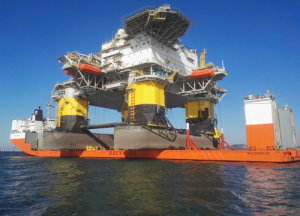
With less capital to go around, the total active drilling rig count in Nigeria – including both offshore and onshore units – decreased from 38 in January 2015 to 27 in Q4 2015, said Sola Falodun, IADC Nigeria Chapter Chairman. Mr Falodun also serves as General Manager, Drilling & Completions System for Nigeria-based Oando Energy Services. According to Mr Falodun, there is substantial pressure on drilling contractors to cut dayrates – sometimes by as much as 40%. “Of course, the operators still expect the contractors to provide optimum performance. The onus then falls on the drilling contractor looking inward to challenge itself to operate in this new low-priced regime.”
Mr Falodun said most multinational drilling contractors with rigs rolling off contract are opting to move assets elsewhere in the world where there might be more opportunity for work. Rigs that are kept in Africa are being cold stacked. In contrast, indigenous drilling contractors have gone the route of warm stacking their rigs without work, he noted. This is being done with the hope that the Nigerian government’s contractual policies might change in the near future, thus making the region more attractive for increased drilling activity. Of all stacked rigs in Nigeria, he estimated there is a 50/50 split of warm and cold-stacked assets.
“Our contractual cycle is very long. Typically, it takes anywhere from 24 to 36 months to mature a contract from the prequalification stage to contract award,” Mr Falodun said. “We think that can be significantly reduced to six months if the right policies are put in place.” He also expressed the need for a more favorable split between joint venture contracts and production-sharing contracts between the Nigerian government and IOCs.
The Nigerian government originally tried to pass the Nigerian Petroleum Bill in 2012, which would have split the Nigerian National Petroleum Corp (NNPC) into five entities. However, the bill never became law because the country’s National Assembly couldn’t reach a unanimous agreement. In December 2015, an updated petroleum bill, the Petroleum Industry Governance and Institutional Framework Bill 2015, was drafted. Under this bill, the NNPC would be divided into only two entities – the Nigeria Petroleum Assets Management Company (NPAM) and the National Oil Company (NOC). “The reforms are ongoing,” Mr Falodun said, noting an expectation that industry could begin to see changes take place as early as this year.
Total to push African production
When profits are drastically reduced, investments must adjust accordingly. At Total, the full exploration budget will be cut from $3 billion in 2014 to about $2 billion in 2015. This is allowing for development of core projects in Africa to continue. “Some wells have been postponed, but our main major development projects are continuing,” Mr Ludot said. The company expects to decrease its rig count in Africa from 12 in 2015 to fewer than 10 in 2016. Those rigs that remain have up to five years left on their contracts.
Regardless of the falling rig count, however, Mr Ludot said Total is planning for a 20% increase in its African production by 2019. This will be achieved with the significant contribution of deepwater projects, as well as shallow-water ones. In 2014, 75 wells that Total drilled in Africa were located in its three major West Africa deepwater projects – the Kaombo in Angola, the Egina in Nigeria and the Moho Nord in the Congo. In 2015, the number of wells dropped to 65, and for 2016 the company plans to drill 55-60 wells. “We are reducing the number of wells in 2016 just by removing infield wells in major fields that are not economical anymore,” Mr Ludot said.
Although exploration has been reduced for now, Total remains hopeful that cost reductions throughout the supply chain will make those opportunities more viable in the near future – particularly offshore South Africa and onshore Uganda. “We are optimistic that all engineers from operators, service companies and drilling contractors will design new and optimized development plans that will be able to work in a lower-price environment,” he said. “The industry will be able to adapt.”
Rig design is one specific area where Mr Ludot sees potential for additional cost reductions. “Today, deepwater rigs are not really designed for development; they are designed for exploration.” If the industry were to design deepwater rigs with development in mind, that could make larger-scale projects, such as the three Total is completing in West Africa, more efficient to operate.
Integration of rig facilities and services could be another point of cost reduction. In areas like routine maintenance or workover operations, for example, contracts can be consolidated between the supply chains, Mr Ludot suggested. “Today, when we do development, we award about 20-30 contracts and technical solutions, but these are not well integrated.” He also pushed for getting drilling contractors involved earlier in a project’s design phase. That’s the only way operators, drilling contractors, vendors and suppliers can collaborate to reduce costs. “We have no choice – we have to do it.”
Semi tender rig market
Barge tender assist rigs have dominated the tender rig market in the past. However, that trend may be changing. “Historically, barges have been used in benign environments,” Atlantica Tender Drilling COO Mike Cadigan said. However, since the early 2000s, the use of semi tender rigs have become more pervasive due to their ability to operate in harsher weather conditions and in deeper water depths than barge rigs. In fact, Mr Cadigan said he believes newer semi tender assist-style rigs will become the next generation of tender rigs as older barge rigs get scrapped over the next two to three years. “There are a lot of rigs that are old in the tender market segment, so there’s a lot of attrition candidates.”
Atlantica, which focuses on the offshore market between South America and Africa, has a newbuild semi tender rig – the Atlantica Delta – set for deployment to the Congo in Q1 2016. The rig is contracted with Total for 3 ½ years and set to work on the Moho Nord project in the Moho-Bilondo license, approximately 75 km off the coast of Pointe Noire.
The rig, which will be used with a tension leg platform (TLP), was chosen for its ability to drill deeper wells than a barge tender assist could and for its lower cost than a typical floater, according to Atlantica. “Other TLPs that have been out there typically just have their own platform rigs on the TLPs, but we’re using the tender assist, which allows them to keep the footprint much smaller and allows them to lower the capital costs by just having a lighter-weight drilling package,” Mr Cadigan said.
Atlantica’s Alpha, a barge tender assist, last year had its contract with Total terminated a few months early due to cost-cutting measures. “It was working over some existing older wells,” he noted. The rig, more appropriate for shallow-water and low-cost workover work, is now warm-stacked in the Congo. “We feel that the rig is a good candidate to go back to work (in 2016), so we decided we didn’t want the rig to be laid up.”
East Africa likely on hold
Although East African drilling developments were on the move pre-downturn, low oil prices have paused most activity in this part of the continent. “There’s a general reduction in drilling activity arising from a sharply cut budget, especially on exploration,” said Mwendia Nyaga, CEO of Oil & Energy Services. “Most of East Africa is at the exploration stage, so when exploration budgets are cut, then we are affected accordingly.”
In Kenya, the number of onshore rigs had dropped from five in late 2014 to just one by Q4 2015, he said. All rigs had been doing exploration drilling and were under contract with Tullow Oil, including the one that’s still working. “For the one remaining, there has been significant downward pressure on cost of drilling, which means less revenue,” Mr Nyaga said. In fact, he believes that if oil prices remain at or below $50/bbl, Kenya’s rig count will likely shrink to zero by Q2 this year. He said $60-$70 oil will likely be needed to make exploration in Kenya viable again.
Effects of the downturn are similar for Kenya’s western neighbor, Uganda. The country, which has an estimated 6.5 billion bbl of oil in place and where 120 total wells have been drilled to date, saw activity drop sharply as oil prices began falling in 2014. Two rigs that were operating onshore were let go in late 2014, and the country hasn’t had any rigs drilling since then. “There’s absolutely no rigs there now,” Mr Nyaga said. And if prices don’t increase, there likely won’t be any rigs operating in Uganda in 2016, either.
When oil prices do rise, however, that will likely lead to an increase in drilling activity for Tullow in the South Lokichar Basin in Kenya, which has an estimated 600 million bbl of oil. Tullow is expected to present plans to the Kenyan government in early 2016 for new development wells in the region, according to Mr Nyaga. If the plans are approved, that could mean hundreds of wells to be drilled between the two countries over the next three years – dependent on oil prices. With higher oil prices, drilling could begin as early as 2017, he said, with more than 10 onshore rigs operating in each country.
Two other East Africa nations with notable oil and gas potential are Tanzania and Mozambique. Tanzania, which has an estimated 55 TcF of natural gas reserves in place, has two onshore rigs and one offshore rig operating. The Tanzania Petroleum Development Company is operating a small project meant to produce natural gas for local consumption, supplied by the 105-sq-mile (170-sq-km) Songo Songo Development. First gas in the 470-sq-mile (756-sq-km) Mnazi Bay Development was delivered in August 2015, with proven reserves amounting to 89.2 BCF. Also located in Tanzania is the Kiliwani North Development. Proven reserves there amount to 45 BCF, although production has yet to start.
Nearby Mozambique’s total natural gas discovered is estimated at more than 180 TcF, but the country currently has just one rig operating offshore. So far, the number of wells drilled in the country amount to 105 exploration wells, 55 appraisal wells and 22 production wells. “There is some heavy investment expected to develop LNG plans in both of these two countries,” Mr Nyaga said. However, any additional activity will likely be put on hold until oil prices improve. “The environment is such that it’s expected there will be challenges in raising the required funding.”
Building the next hub
Recognizing the long-term potential for Africa, the Canary Islands – located only 100 km from the West African coast – is looking to set itself up as a hub for the oil and gas industry. “We really think that Africa is the next frontier for the oil and gas industry, said Queila Delgado, Economic Representative of the Canary Islands Government at the Spanish Embassy. “And now that the industry is looking at how they can be more competitive and cost effective through the crisis, I think the Canary Islands can bring an opportunity to the companies operating in West Africa.”
The number of flights connecting Africa with resources in Europe is one advantage. Pablo Martín, Director General for the Regional Ministry of Economy, Industry, Commerce and Knowledge for the Canary Islands, said equipment can be sent over from cities such as Aberdeen and Stavanger “within the day.” Additionally, when a rig needs maintenance or repairs, sending the rig to those cities can take 17 to 20 days. But a trip to the Canary Islands would take only about seven days, he said. Several service centers have already been opened in the Canaries, including facilities from companies like Subsea Masters, Subsea Services, Rolls Royce, Repsol and Otech. DC
IADC Nigeria Chapter pushes for better equipment access, workforce training
By Alex Endress, Editorial Coordinator
Although growth in the Nigerian drilling sector leveled off in 2015, as it did around the globe, efforts to improve workforce training and access to reliable equipment continue. For the IADC Nigeria Chapter, these two points top the list of goals for improvement in 2016. “My vision is to see a thriving and efficient drilling industry in Nigeria that can compete with any other part of the world,” Nigeria Chapter Chairman Sola Falodun said. Mr Falodun is also General Manager, Drilling & Completions System, for locally based Oando Energy Services.
For Nigeria to become an elite global drilling community, access to equipment and top-notch training must be up to par with other drilling markets. Currently, access to equipment is a problem, not only for Nigeria but also for West Africa as whole. The region has no local service facility for supply and maintenance of critical drilling equipment, such as BOPs and top drives. “Equipment reliability depends on having adequate support from OEMs. It requires setting up a far-ranging innovative service facility in Nigeria that can repair, maintain and satisfy some of the rig’s critical equipment. This sort of access is imperative to ensure asset integrity is properly maintained.”
The issue of access to service facilities may not be as big of a problem for international drilling contractors with worldwide networks. However, because the closest service facilities are currently in South Africa, Europe or the US, Nigeria’s local drilling contractors must spend extra money to transport equipment internationally and pay extra rental fees for replacement parts. “We are examining avenues to encourage manufacturers to come set up in Nigeria or any West African country because that would significantly reduce operating costs for drilling contractors and, of course, for the IOCs.”
The IADC Nigeria Chapter is currently pitching West Africa as a service location to international OEMs and hopes to have a large supplier located in the region by 2017.
As for training, Nigeria is experiencing the same competency gap issues as many other African countries. The main factor contributing to the gap is the challenge of attracting experienced and well-trained young employees to the region. Underscoring this gap, the Nigerian Chapter completed a study on local drilling contractors that showed companies are seeing a range of 10%-20% total NPT due to human errors. “We realized that some of those drilling companies don’t have the appropriate curricula or the resources to be able to train people for rig operations. So we’ve actively reached out and informed companies about the readily available resources that can be acquired via the IADC.” Mr Falodun said the Nigeria Chapter reaches out to companies in need of help to direct them toward free resources such as the IADC Knowledge, Skill and Ability competencies database (KSA) while they train young workers.
Due to local content laws in many African countries requiring companies to employ certain percentages of localized labor on rigs, he said, it’s important to recruit from the local population. “Even the multinational drilling contractors realize the primary importance of local recruitment because there is a quota on the number of expatriates a company can bring into the country – not just Nigeria but any African country.”
If the chapter’s goals for improved workforce training can be achieved, Mr Falodun said, he anticipates drilling contractors in Nigeria will see an overall improvement in operational safety and, hopefully, minimized NPT. In the midst of significant cost-cutting measures, this would take commitment from all parties involved. “In spite of the widespread global economic recession and the downturn within the industry, we have to optimize performance collaboratively with the IOCs. Together, we can uniquely position ourselves for win-win scenarios, so drilling contractors can meet their obligations to their employees and their shareholders.”
Click here for more information on the IADC Nigeria Chapter.




